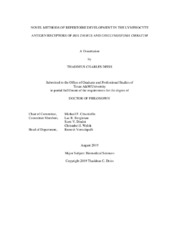| dc.description.abstract | The adaptive immune system of all jawed vertebrates relies on B and T cell effectors bearing immunoglobulin superfamily (IGSF) antigen receptors called B and T cell receptors (BCR, TCR). These antigen receptors are borne from distinct loci requiring genomic rearrangement of variable (V), diversity (D), and joining (J) gene segments, allowing a near infinite repertoire to be encoded within confined loci. Gene rearrangement events, carried out by the recombination activating genes (RAG), massively expands diversity in complementary determine regions (CDRs), loops forming the receptor-ligand interface. IGSF receptors can also be altered by activation induced cytidine deaminase (AID) activity to hone response specificity or to expand the primary repertoire. Bovine BCRs undergo AID mediated somatic hypermutations (SHM) to diversify the naïve repertoire. The Bos taurus antibody repertoire is characterized by a subset of immunoglobulin heavy (IgH) receptors encoding ultralong CDR3 regions greater than forty amino acid residues in length. Ultralong CDR3 BCR rearrangements are genetically constructed with a propensity to yield Cys residues when mutated. The Cys residues are integral in facilitating the unique ‘knob’ domain which protrudes from a β-ribbon stalk. This protruding knob is held far from the other CDRs and forms the primary paratope of the molecule. This miniscule paratope can be further honed by AID mediated deletion events conferring unique structural motifs compared to full length knobs.
The TCR repertoire of Ginglymostoma cirratum employs Ig-TCRδ rearrangements that blend gene segments from distinct BCR and TCR loci. These receptors make use of IgH V segments to diversify the existing TCRδ repertoire. Sequencing of the Ig-TCRδ repertoire identified these rearrangements stemmed from a number of IgH mini-cluster loci as well as a distinct lineage of Ig-like V segments located within the TCRδ locus termed TAILV segments. Quantification of Ig-TCRδ transcripts determined they were just as common as canonical TCRδ receptors in this ancient iteration of adaptive immunity, and could be found localized on the cell surface presumptively playing an active role in shark immunity. These novel methods of repertoire development showcase the malleability of the IGSF system in developing a massively diverse repertoire to protect an organism from the antigenic onslaught of life. | en |


